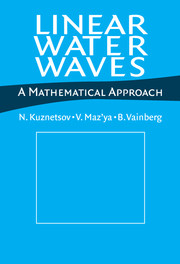Preface
Published online by Cambridge University Press: 14 October 2009
Summary
Now, the next waves of interest, that are easily seen by everyone and which are usually used as an example of waves in elementary courses, are water waves. As we shall soon see, they are the worst possible example, because they are in no respect like sound and light; they have all the complications that waves can have.
—The Feynman Lectures on Physics, Vol. 1, Section 51.4 (86)The aim of the present book is to give a self-contained and up-to-date account of mathematical results in the linear theory of water waves. The study of different kinds of waves is of importance for various applications. For example, it is required for predicting the behavior of floating structures (immersed totally or partially) such as ships, submarines, and tension-leg platforms and for describing flows over bottom topography. Furthermore, the investigation of wave patterns of ships and other vehicles in forward motion is closely related to the calculation of the wave-making resistance and other hydrodynamic characteristics that are used in marine design. Another area of application is the mathematical modeling of unsteady waves resulting from such phenomena as underwater earthquakes, blasts, and the like.
The history of water wave theory is almost as old as that of partial differential equations. Their founding fathers are the same: Euler, Lagrange, Cauchy, Poisson. Further contributions were made by Stokes, Lord Kelvin, Kirchhoff, and Lamb, who constructed a number of explicit solutions.
- Type
- Chapter
- Information
- Linear Water WavesA Mathematical Approach, pp. xi - xviiiPublisher: Cambridge University PressPrint publication year: 2002



